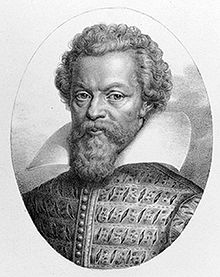- Philippe de Mornay
-
Philippe de Mornay (5 November 1549 – 11 November 1623), seigneur du Plessis Marly, usually known as Du-Plessis-Mornay or Mornay Du Plessis, was a French Protestant writer and member of the Monarchomaques ("killer of kings").
Biography
He was born in France, now situated in Val-d'Oise. His mother had leanings toward Protestantism, but his father tried to counteract her influence by sending him to the Collège de Lisieux at Paris. On his father's death in 1559, however, the family formally adopted the reformed faith. Mornay studied law and jurisprudence at the University of Heidelberg in 1565 and the following year Hebrew and German at the University of Padua. On the outbreak of the second religious war in 1567, he joined the army of Condé, but a fall from his horse prevented him from taking an active part in the campaign. His career as Huguenot apologist began in 1571 with the work Dissertation sur l'Église visible, and as a diplomat in 1572 when he undertook a confidential mission for Admiral de Coligny to William the Silent, Prince of Orange.
He escaped the St. Bartholomew's Day Massacre by the aid of a Catholic friend, and took refuge in England. Returning to France towards the end of 1573, he participated during the next two years with various success in the campaigns of Henry IV of France, then King of Navarre only. He was taken prisoner by the Duke of Guise on 10 October 1575, but ransomed for a small sum, which was paid by Charlotte Arbaleste, whom he married shortly afterwards at Sedan. Mornay was gradually recognized as Henry's right-hand man, representing him in England from 1577 to 1578 and again in 1580, and in the Low Countries 1581-1582. With the death of the Duke of Alençon-Anjou in 1584, by which Henry was brought within sight of the throne of France, the period of Mornay's greatest political activity began, and after the death of the Prince of Condé in 1588 his influence became so great that he was popularly styled the "Huguenot pope". He was present at the siege of Dieppe, fought at Ivry, and was at the siege of Rouen in 1591-92, until sent on a mission to the court of Queen Elizabeth. Both he and his wife befriended English protestants like Francis Walsingham, Mary Sidney and her brother Philip Sydney.
He was bitterly disappointed by Henry IV's abjuration of Protestantism in 1593, and gradually withdrew from the court, devoting himself to the Academy of Saumur, which had a distinguished history until its suppression by Louis XIV in 1683.
His last years were saddened by the loss of his only son in 1605 and of his devoted wife in 1606, but he spent them in perfecting the Huguenot organization. He was chosen a deputy in 1618 to represent the French Protestants at the Synod of Dort, and though prohibited from attending by Louis XIII, he contributed materially to its deliberations by written communications. He lost the governorship of Saumur at the time of the Huguenot insurrection in 1621 in the Capture of Saumur, and died in retirement on his estate of La Forêt-sur-Sèvre (Deux-Sèvres).
Works
In 1598 he published a work on which he had long been engaged, entitled De L'institution, usage et doctrine du saint sacrement de l'eucharistie en l'église ancienne, containing about 5000 citations from the scriptures, fathers and schoolmen. Jacques Davy Du Perron, bishop of Évreux, afterwards cardinal and archbishop of Sens, accused him of misquoting at least 500, and a public disputation was held at Fontainebleau on 4 May 1600. Decision was awarded to Du Perron on nine points presented, when the disputation was interrupted by the illness of Mornay. Mornay was also instrumental in the drafting of the Edict of Nantes (1598) which established political rights and some religious freedom for the Huguenots.
His principal works, in addition to those mentioned above, are Excellent discours de la vie et de la mort (London, 1577), a bridal present to Charlotte Arbaleste; Traité de l'Église où l'on traite des principales questions qui ont été mues sur ce point en nostre temps (London, 1578); Traité de la vérité de la religion chrétienne contre les athées, épicuriens, payens, juifs, mahométans et autres infidèles (Antwerp, 1581); Le mystère d'iniquité, c'est à dire, l'histoire de la papauté (Geneva, 1611). Two volumes of Mémoires, from 1572 to 1589, appeared at La Forêt (1624–1625), and a continuation in 2 vols. at Amsterdam (1652); a more complete but very inaccurate edition (Mémoires, correspondances, et vie) in 12 vols. was published at Paris in 1624-1625. He is also one -- many consider the most likely -- candidate for being author of the Vindiciae contra tyrannos (1579), a pamphlet advocating resistance to the French crown.
References
- Life of Mornay written by his wife for the instruction of their son, Mémoires de Mme Duplessis-Mornay, voi. i. in the ed. of Mémoires et correspondences de Duplessis-Mornay (Paris, 1824–1825);
- E. and E. Haag, La France protestante, article "Mornay";
- J. Ambert, Du Plessis-Mornay (Paris, 1847);
- E. Stahelin, Der Übertritt K. Heinrichs IV. von Frankreich zur katholischen Kirche (Basel, 1856);
- Weiss, Du Plessis Mornay comme théologien (Strassburg, 1867).
- Article "Du Plessis-Mornay" by T. Schott in Hauck's Realencyklopädie
- Article by Grube in Kirchenlexikon.
 This article incorporates text from a publication now in the public domain: Chisholm, Hugh, ed (1911). Encyclopædia Britannica (11th ed.). Cambridge University Press.
This article incorporates text from a publication now in the public domain: Chisholm, Hugh, ed (1911). Encyclopædia Britannica (11th ed.). Cambridge University Press.
Categories:- 1549 births
- 1623 deaths
- People from Val-d'Oise
- Huguenots
- Synod of Dort
- Monarchomachs
Wikimedia Foundation. 2010.

